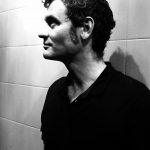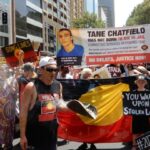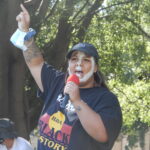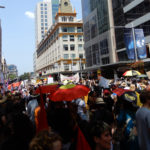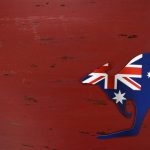January Twenty-Six Is a Day of Mourning: The Sydney Invasion Day Rally

“Today is a national holiday. It’s a time to go and have a beer and a barbeque and celebrate the genocide of our people,” social justice activist Elizabeth Jarrett told the thousands before her.
“Today represents a day of violence. It represents murders, rape and continued genocide.”
“Australia Day will be no more,” the Gumbaynggirr Dunghutti Bundjalung woman declared at Sydney Town Hall on 26 January. “There are no more Australia Day celebrations. It’s Invasion Day. It’s the survival of our people.”
The 26th of January holds significance as the day British ships arrived at Kamay-Botany Bay to commence the takeover of the continent, under the pretext of terra nullius: a legal falsehood the High Court overturned in its 1992 Mabo decision.
The turning of the date this year marked 234 years since the launch of that colonial project, and First Nations people have been officially recognising the 26th as a Day of Mourning since 1838.
Jarrett made a call out to the Aboriginal Tent Embassy in Canberra, which was marking its fiftieth year in operation. Sparked by a McMahon government decision to deny First Nations land rights, the action is now the longest ongoing protest site in the world.
“Why do we have to promote our invasion to make sure Australia sees us?” Jarrett asked, and she listed continuing colonial atrocities: the murders, the rapes, the stealing of children, the poisoning of land and rivers, the denunciation of languages and the desecration of culture.

Ongoing genocide
The point being made at Invasion Day protests is not only does white Australia stop to celebrate the day genocide was unleashed upon the over 500 First Nations that exist on this continent, but further, it’s that the attempted destruction of these Indigenous populations continues.
“This year marks 41 years since my uncle Eddie was murdered in Wee Waa police cells,” explained Kyah Patten. “They arrested him and 45 minutes into his arrest, he was pronounced dead.”
“Where did he get the rope to hang himself from in the cell?”
Eddie Murray’s death occurred in NSW police custody on 12 June 1981. The 21-year-old Gamilaraay man’s death was one of 99 custodial casualties that the Royal Commission Into Aboriginal Deaths in Custody considered in its inquiries.
Murray was said to have been found hanging in his cell, having taken his own life. But an autopsy found he was too intoxicated to have even tied the knot to commit the act. And after his body was exhumed in 1997, a second autopsy revealed a broken sternum.
“He was bashed to death, then hung in his cell to make out that he killed himself,” Patten continued. “Still to this day, 41 years later, we have not seen justice.”
However, since the Royal Commission, at least 485 more Aboriginal and Torres Straits Islander people have died in the custody of either police or corrections.
Last year saw 30 years since the inquiry handed down its final report, yet 16 First Nations custodial deaths transpired over that same 12 months.
Murray’s niece pointed out that not one police or corrections officer has even been convicted in relation to any of these deaths, which, she noted, are all occurring on their own land.
“This system was built to keep us down, and it’s still keeping us down,” Patten added.

The dispossession era
“To the non-Indigenous people here today, I want to remind them that the intergenerational trauma is ongoing. We live it every day,” said Yorta Yorta woman Amanda Morgan. And she recalled that her brother’s father and his eleven siblings were all stolen and placed on a mission.
The Protection Era is a period of history that white Australia prefers to keep hidden. It commenced in the late 1860s with the passing of Victoria’s so-called Aboriginal protection laws, with similar such legislation being enacted in WA in the 1880s, as well as in other state jurisdictions after federation.
So-called protection laws facilitated the forced removal of First Nations people from their land and food sources. The British destroyed tens of thousands of years-old Indigenous economies and stripped the people of their wealth.
The First Peoples were then placed on reserves, missions and stations, where police managed all aspects of their lives and enforced prohibitions on speaking their own languages and the practising of customs.
This dispossession program further involved the Stolen Generations, which saw thousands of children forcibly removed from their families and placed in boarding schools, with girls often being sent on to work as domestic servants in white households.
Structural racism
According to Morgan, First Nations people continue to face dispossession under various “racist government policies”, which cut off individuals from their families, their cultures and their communities.
The 2021 Productivity Commission report outlines that in 2019-20, 41 percent of children in out-of-home care were Indigenous, yet they only account for 5 percent of the overall youth population. And being placed in state care makes a youth more likely to end up in prison in later life.
Right now, Aboriginal and Torres Strait Islander people are the most incarcerated people on the planet. Whilst they only make up 3 percent of the overall populace, First Nations people account for 30 percent of the Australian adult prisoner population.
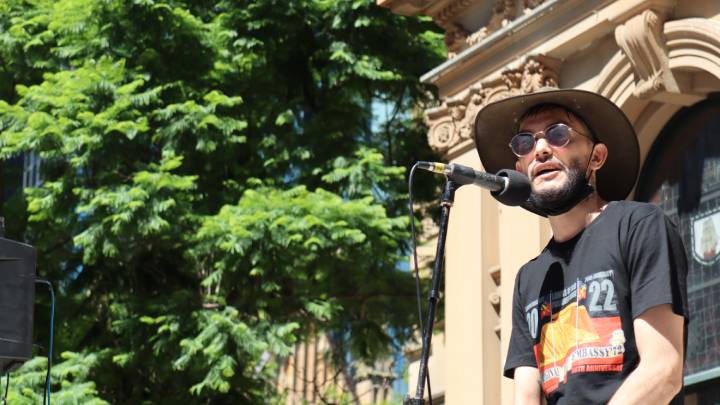
Truth-telling
The first Day of Mourning protest took place in Sydney on 26 January 1838. It met at Sydney Town Hall, before silently marching to Australia Hall at 150 Elizabeth Street, where discussions were held around securing rights and equality in the community.
Just prior to this year’s rally taking to the streets, Ualaroi Kamilaroi Weilwan Murdi Clayton Simpson-Pitt explained to the crowd that it would be following the same route as the original march in commemoration of it.
“We need to tell the truth. We need a truth commission here in NSW,” continued Simpson-Pitt, the chief executive of the NSW Aboriginal Land Rights Association (NSWALRA). “And how we are going to address that is through a truth and justice commission.”
The land rights activist added that his organisation launched its campaign that day to see a NSW Truth and Justice Commission established. The NSWALRA aims to get the issue onto the political agenda in the lead up to next year’s state election.
“We can find out the truth of what happened here in this country, on this land. We can find out why our people are still renting on our own land. We’ve been renting for too long,” Simpson-Pitt concluded.
“Aboriginal people across NSW don’t own our land: that has to change. And how we are going to change that is through our truth and justice commission.”
